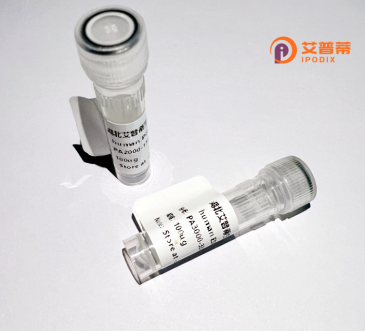
| 纯度 | >90%SDS-PAGE. |
| 种属 | Human |
| 靶点 | APOBEC2 |
| Uniprot No | Q9Y235 |
| 内毒素 | < 0.01EU/μg |
| 表达宿主 | E.coli |
| 表达区间 | 1-224aa |
| 氨基酸序列 | MAQKEEAAVA TEAASQNGED LENLDDPEKL KELIELPPFE IVTGERLPAN FFKFQFRNVE YSSGRNKTFL CYVVEAQGKG GQVQASRGYL EDEHAAAHAE EAFFNTILPA FDPALRYNVT WYVSSSPCAA CADRIIKTLS KTKNLRLLIL VGRLFMWEEP EIQAALKKLK EAGCKLRIMK PQDFEYVWQN FVEQEEGESK AFQPWEDIQE NFLYYEEKLA DILK |
| 分子量 | 25.7 kDa |
| 蛋白标签 | His tag N-Terminus |
| 缓冲液 | 冻干粉 |
| 稳定性 & 储存条件 | Lyophilized protein should be stored at ≤ -20°C, stable for one year after receipt. Reconstituted protein solution can be stored at 2-8°C for 2-7 days. Aliquots of reconstituted samples are stable at ≤ -20°C for 3 months. |
| 复溶 | Always centrifuge tubes before opening.Do not mix by vortex or pipetting. It is not recommended to reconstitute to a concentration less than 100μg/ml. Dissolve the lyophilized protein in distilled water. Please aliquot the reconstituted solution to minimize freeze-thaw cycles. |
以下是与重组人编辑酶APOBEC2相关的3篇参考文献,按文献名称、作者和摘要内容简要概括:
---
1. **"Structure of human APOBEC2 reveals a novel dimeric conformation and functional implications"**
- **作者**: Kouno T, et al.
- **摘要**: 通过X射线晶体学解析了人APOBEC2的蛋白结构,揭示了其独特的二聚体构象,并推测其可能通过底物识别调节RNA/DNA编辑活性,区别于其他APOBEC家族成员的单体或多聚体形式。
2. **"APOBEC2 regulates myoblast differentiation via mRNA editing and chromatin remodeling"**
- **作者**: Prohaska KM, et al.
- **摘要**: 研究揭示了APOBEC2在肌肉分化中的作用,其通过靶向特定mRNA的编辑(如肌细胞相关基因)和调控染色质修饰复合物(如HDACs),影响肌细胞的生成与功能。
3. **"APOBEC2 deficiency accelerates skeletal muscle regeneration through enhanced satellite cell activation"**
- **作者**: Sato Y, et al.
- **摘要**: 发现APOBEC2基因敲除小鼠的卫星细胞激活和肌肉再生能力显著增强,表明APOBEC2可能通过抑制过度增殖或促进分化平衡来调控肌肉组织稳态。
---
以上研究涵盖了APOBEC2的结构特性、在肌肉分化中的调控机制,以及与组织再生相关的功能。如需具体论文信息或补充文献,可进一步说明。
APOBEC2 (apolipoprotein B mRNA-editing enzyme catalytic polypeptide-like 2) is a member of the APOBEC family of cytidine deaminases, which play diverse roles in RNA/DNA editing, innate immunity, and genome maintenance. Initially identified as a homolog of AID (activation-induced deaminase), APOBEC2 shares a conserved zinc-dependent catalytic domain critical for deamination activity but exhibits distinct functional and structural characteristics. Unlike other APOBEC proteins (e.g., APOBEC3 subfamily) that primarily target viral or retrotransposon nucleic acids to restrict pathogens, APOBEC2’s physiological role remains less understood. It is expressed predominantly in skeletal muscle and heart tissues, suggesting tissue-specific functions. Studies indicate potential involvement in muscle cell differentiation, lipid metabolism, or regulating gene expression via RNA editing, though direct substrates are yet to be fully defined. Recombinant APOBEC2 has been explored for biotechnological applications, including engineered genome-editing tools, but its catalytic activity on DNA/RNA substrates appears weaker compared to other APOBECs. Recent research highlights its non-catalytic roles, such as influencing cell proliferation and interacting with proteins involved in muscle development. Despite progress, mechanistic details of APOBEC2's biological functions and its evolutionary divergence within the APOBEC family require further investigation, making it a topic of interest in both basic and applied biomedical research.
×